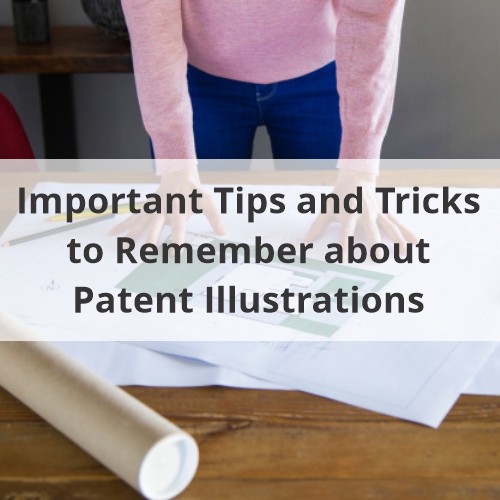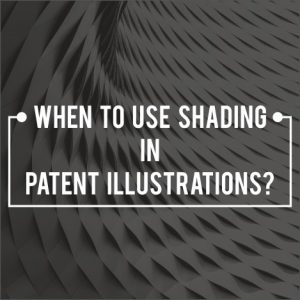Patent illustrations are a pivotal part of your patent application. Even if you have a phenomenal way with words while describing your invention, using patent illustrations is a great tool. An examiner runs a fine-tooth comb over your application. This involves comparisons with any relevant prior art. In order to boost your chances of getting a grant, you have to ensure that your claims and specifications stand out. A simple hack is utilizing your patent illustrations to the maximum. Furthermore, a good illustration helps you beyond the grant of your patent application. In patent infringement cases, a judge can make a more informed decision if your drawing is precise. However, ensure that you adhere to the USPTO guidelines so that your illustration helps your case and not hamper it.
This article aims to shed light some key tips to remember about patent illustrations.
Why do you need patent illustrations?
You need to include at least one patent illustration to explain your invention better. A patent illustration not only compliments your descriptions but it’s also a requirement under the US Patent Law. Your application might not make the cut if the description is vague or generic. The reason is that this makes it easier to find an overlapping prior art for it. Your explanation of the invention needs to be elaborate and distinct. Hence, including patent illustrations is always advisable.
What are the requirements of patent illustrations?
We shall now talk about the basic rules. Following are the vital instructions from The Manual of Patent Examining Procedures that you need to adhere to:
- Create all your illustrations on white A4 matte paper that is flexible and strong. Dimensions are as follows: 21cm x 29.7cm or 21.6cm x 27.9 cm.
- Margins should be as follows:
- 2.5 cm on the top
- 1.0 cm on the bottom
- 1.5 cm on the right side
- 2.5 cm on the left side
- Every illustration must be black and white in color and no other color.
- You may use colors only when a part of the invention absolutely requires you to use different colors while explaining. You must also file a separate petition with the USPTO to avail permission for the same.
- You must use India ink for all illustrations.
- Each illustration must include the invention name, name of the inventor, and application number.
- Ensure that the upon rescaling the drawing, it will not be crowded when reproduced at 2/3 size. Don’t write indications of scale like “1/2” because that will lose its meaning upon rescaling.
- You may use symbols and legends if necessary to describe the invention.
- Use lead lines to redirect the reader from the drawing to the associated symbol in the description.
- You can also include charts and diagrams in your illustrations.
- The manual encourages you to use shading. However, avoid solid black shading except on bar graphs or to represent color.
- Superimposition of drawings should not happen.
- You don’t need an illustration if your patent is about a chemical compound or process.
The USPTO allows you to use photos, but only for Utility patents and Design patents. Photographs serve the purpose of providing intricate details of the invention which might be hard to draw. Hence, they must be in high definition to depict everything clearly. They must follow the same rules in terms of the type, size, and margins of the drawing.
Related article: When to use shading in Patent Illustrations?
Click Here to Download (Free Samples)
Patent illustrations: Views
If your invention is a physical object, you should cover all the angles; top, bottom, and all the sides. Wherever applicable, you should include the following views of your invention:
- Six views (front, back, right, left, top, and bottom) for 3D objects and two views (front and back) for 2D objects.
- Three-dimensional perspective views
- Sectional views to depict the functionality
- Exploded views to represent how each part works during the operation of the invention
You can choose not to depict the surfaces which are without ornamentations. We told you before that the USPTO law encourages shading. It is another essential component of patent illustrations. It depicts depth, contour, and texture. You should use dots, lines, and distinctive patterns for this.
How to make the illustrations?
You now know the important parameters to keep in mind while making patent illustrations. But how to finally create them? Generally, there are 3 broad ways to obtain your patent illustrations:
Hand-made Drawings
If you’re proficient in illustration skills and the invention is easy to represent then you can simply draw them yourself. However, consulting an expert to ensure that your drawings meet the USPTO requirements is a safe option. There is nothing wrong with hand-made illustrations. Therefore, as long as it’s serving the purpose of fully describing the invention and follows all guidelines, you can use it.
Computer Aided Design (CAD) Software Drawings
You can also use CAD software to create professional-grade patent illustrations. Such software has a wide variety of features which help you save a lot of time. It becomes easier to produce elaborate drawings and make changes to existing drawings when you are using a computer. Essentially, right from rendering a new drawing to reproducing one with modifications, working on a computer is faster and simpler. However, the use of such software drawings come with a little bit of a risk in the form of errors. So it is safer to consult a patent illustrator for your drawings.
Patent Illustrators
If creating your own drawings seems difficult for you, then you can seek professional assistance. Patent illustrators have a good understanding of the USPTO requirements for the drawings and are proficient in various illustration methods. A patent illustrator can make both hand-made and CAD drawing for you. Of course, there is a reassurance in their work because they have the right experience and knowledge. Hence, they can help you decide the best way to depict your invention to the best advantage.
Need a professional illustrator? – Patent Illustration Express
It is often the case that producing your own patent illustrations becomes overwhelming. The margins for error are too fine and the guidelines are too many. If you feel the need to consult a professional, Patent Illustration Express is here to help you. Our team of professionals boasts years of experience and diverse skill-set of software and handmade drawings. We specialize in Utility Patent and Design Patent drawings. Your satisfaction is paramount to us. We offer an incredibly high turn around time and unlimited iterations, all at an extremely affordable price. So what are you waiting for?
To make an inquiry, visit the Patent Illustration Express Services.
Other Related Articles:
Virtual IP Paralegal: Why Should You Hire One?



